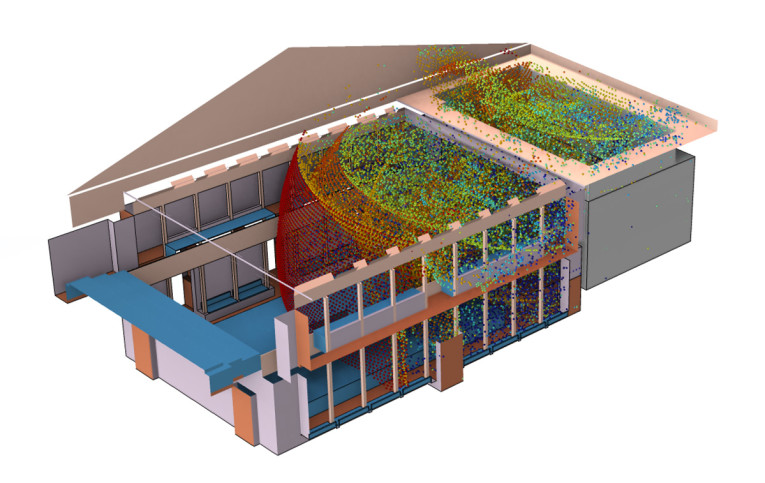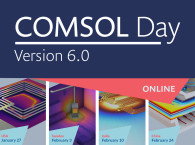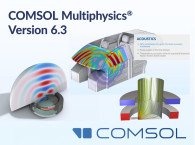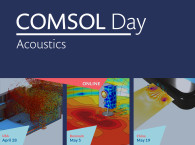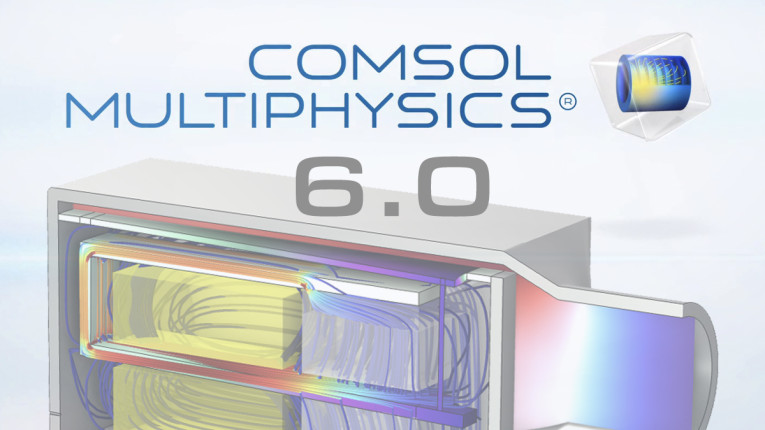
Among many new features, users of the COMSOL Multiphysics 6 Acoustics Module will enjoy the possibility to model piezoelectric phenomena in the time domain for wave propagation using a time-explicit formulation, physics-controlled mesh for pressure acoustics problems, new high-frequency wave methods, and the flow-induced noise capabilities using hybrid CAA with Lighthill's analogy. COMSOL 6.0 also makes gradient based optimization with a transient solver more robust by adding a transient topology optimization model to the Application Library. Other optimizations include an improved UI for parameter estimation and a Transformation shape optimization feature for simple changes, i.e. translation, scaling and rotation.
Listed as the main features for the updated Acoustics Module are the new Piezoelectric Waves, Time Explicit multiphysics interface based on the discontinuous Galerkin (dG) time-explicit method, and two new high-frequency pressure acoustics interfaces for modeling scattering and radiation, based on the high-frequency BEM (HFBEM) method. Flow-induced noise capabilities also now have a new dedicated multiphysics coupling and transient mapping study, while speaker designers will benefit from a new Lumped Loudspeaker boundary condition and sector symmetry options in the exterior field feature.

The Major New Features
Of course, this major software release is much more than the Acoustics Module. COMSOL Multiphysics version 6.0 introduces the Model Manager, the Uncertainty Quantification Module, faster solvers for heat radiation and nonlinear structural materials, new powerful tools for electromagnetics analysis of PCBs, and flow-induced noise. The Model Manager allows colleagues to collaborate and centrally organize models and apps, including access and version control as well as advanced search.
COMSOL’s floating network license allows users from anywhere within and outside of the license holder’s organization to access a centralized Model Manager installation. This also includes collaborators across geographical and territorial borders. Additionally, a local Model Manager installation is included with all licenses — even those that are not floating-network based — to provide a platform for building an individual user’s file storage structure, while updating versions and tracking changes of their modeling projects.
"The Model Manager expands on COMSOL’s cutting-edge multiphysics modeling capabilities and our fast-paced strategy of placing COMSOL Multiphysics as the primary tool for democratizing simulation in the CAE market,” says Svante Littmarck, CEO and president of COMSOL. "We now complement our revolutionary Model Builder and Application Builder, for developing multiphysics models and simulation apps, with the Model Manager for model development and simulation data management. Together, this functionality will facilitate collaboration within engineering groups, across departments and enterprises, and even between countries. This will inevitably lead to better process and manufacturing designs as all competencies of an organization are harnessed effectively.”
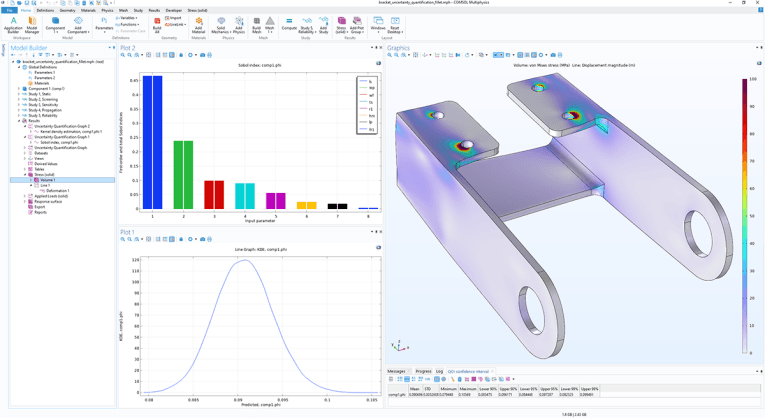
There's also a new Application Builder editor for interactively designing menus and ribbon toolbars, the ability to organize geometry objects and operations in Group nodes, union and boundary layer operations for imported meshes, and improved color tables, including logarithmic scale, for results visualization. Also, ambient occlusion and improved transparency in visualizations now make 3D models appear more realistic. There's also a new option to generate reports as Microsoft PowerPoint presentations.
In the platform support angle, COMSOL users will be happy to know that the new software has support for macOS on M1 processors, which means the ability to benefit from the best performing laptops in the market currently - particularly with the new MacBook Pro M1 Pro and M1 Max showing exponential improvements in dealing with complex geometry and very high resolution images, beating what was previously the realm of the most powerful workstations. And according to COMSOL, version 6.0 also brings performance improvements through speedup and memory consumption by a factor of 10 for certain engineering applications.
Another important area of improvements is electromagnetics simulation of PCB’s, where COMSOL now offers computation of frequency-dependent resistance and inductance matrices for PCBs, as well as adaptive and physics-controlled meshing for microwave and mmWave circuits on PCBs. Designers of mobile and wireless products will be glad with the new hybrid boundary-element–finite-element method (BEM–FEM) for antennas and electromagnetic wave propagation, as well as the ability to model composite electromagnetic shielding materials and nonlinear magnetic materials for RF and microwave components.

In the Electromagnetics area, there are also new tools for electric motors including a Part Library and efficient torque calculations, magnetomechanics analysis for strongly coupled structural and magnetic multiphysics simulations, and a new optical material library with glasses from leading manufacturers.
The updated Structural Mechanics module offers 10x faster solving for creep and faster solving for nonlinear structural materials in general. Significantly easier modeling of mechanical contact with automated generation of pairs and contact conditions is coupled with fast reduced-order modeling using the Craig–Bampton method for dynamic or stationary analysis and improved modeling of shells in imported CAD assemblies. There's also fatigue evaluation for random vibrations, contact with friction in crack modeling, fiber-reinforced linear elastic materials, and wrinkling in membranes.
The new software also improves significantly Fluid & Heat simulations, with 10x increased efficiency in solving surface-to-surface radiation, multiscale modeling of heat transfer in pellet beds, improved LES with automatic wall treatment and thermal wall functions, and high-Mach-number-flow analysis for rotating machinery. In fact, the list of new features in the Fluid & Heat department is one of the most extensive ever, including a new multiphysics interface for nonisothermal flow in porous media.
The Chemical & Electrochemical module now offers multiphysics interface for nonisothermal reacting flow, porous catalyst feature for heterogeneous reactions and adsorption, turbulent reacting flow with diluted species, and the possibility to simulate stresses and strains due to lithium intercalation in lithium-ion batteries. Event sequences for easier modeling of multistep charge/discharge cycles are now available, together with a new material library for fuel cells and electrolyzers, and a new interface for cathodic protection.
Finally, COMSOL v6 now offers the ability to project 3D objects and entities to work planes and 2D geometries; faster and more robust import of ECAD files; improved Detect Interferences tool for interferences between geometry objects, and the ability to do offline synchronization between the COMSOL Multiphysics software and CAD software with the CAD Import Module, Design Module, and LiveLink Products for CAD.
COMSOL v6 for Audio Developers
According to Mads J. Herring Jensen (Technology Manager, Acoustics COMSOL), the Acoustics Module in COMSOL Multiphysics version 6.0 offers new and improved functionality for many applications areas. With this version a new Piezoelectric Waves, Time Explicit interface is launched for modeling wave phenomena in devices with piezo transducers or larger piezo domains.
The interface extends the existing family of acoustic, nonlinear acoustic, and elastic waves physics that use the discontinuous Galerkin time explicit formulation. The method is well suited for modeling acoustically large problems in the time domain and is fully multiphysics enabled. Applications range from modeling nondestructive testing (NDT) systems to ultrasonic imaging systems

In the 6.0 release of COMSOL, computational aeroacoustic (CAA) capabilities for flow-induced noise simulations based in Lighthill’s acoustic analogy are also introduced. The functionality relies on a new multiphysics coupling from an LES fluid flow simulation (this requires the CFD Module) to Pressure Acoustics, Frequency Domain as well as a new dedicated Transient Mapping study.
Two new physics interfaces are also introduced for modeling high frequency wave phenomena based on the so-called high frequency BEM (HFB) or Kirchhoff-Helmholtz method. One interface is dedicated to scattering problems while the other is dedicated at modeling radiation problems. One application area could be to efficiently model the radiated sound from a loudspeaker cabinet at high frequencies.

The 6.0 release also comes with a long list of smaller features and enhancements that will resonate with the transducer and in particular the loudspeaker community. The list of news includes: A new Lumped Speaker Boundary that simplifies setting up hybrid FEM-Lumped models for modeling loudspeakers. The idea being that the electromagnetic parts of a loudspeaker a modeled using an electric circuit (like a TS representation) while the outside acoustics use a full wave FEM model. This is of particular use for modeling how microtransducers are integrated in devices.
Optimization of loudspeakers has been simplified with the introduction of special exterior field variables that can be used in a gradient based optimization context, like shape or topology optimization. The Exterior Field Calculation feature now supports models with sector symmetry. This is a feature that has been highly requested by audio engineers. It is useful when modeling loudspeakers that have some cyclic periodic nature, as it allows easy evaluation of the response of the driver.
December 16, 2021 (2:00pm– 2:45pm CET), Mads Jensen will present a webinar with an introduction to the new features and functionality in the Acoustics Module with COMSOL Multiphysics version 6.0. Register here.
COMSOL Multiphysics, COMSOL Server, and COMSOL Compiler software products are supported on Windows, Linux, and macOS.
www.comsol.com
